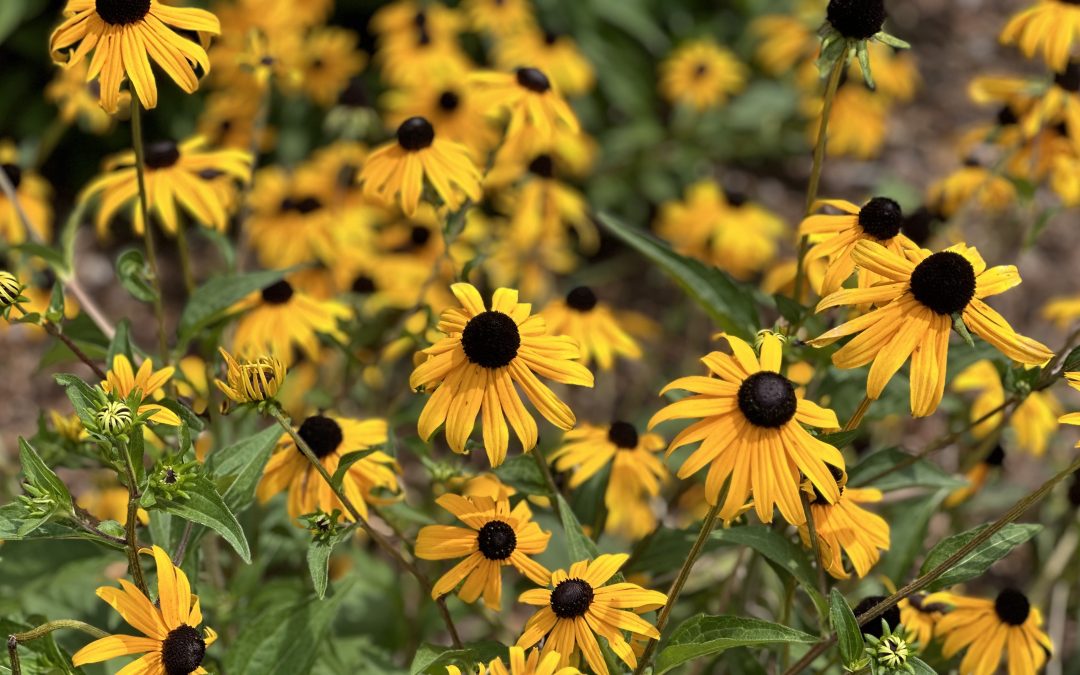
by Abbey Smith | May 23, 2024
Florida’s diverse ecosystem is home to a variety of native plants that provide resources for local pollinators. Native flowers are not only a beautiful addition to any garden but also play a crucial role in maintaining the health of our environment. Planting native species supports the delicate balance of local ecosystems and promotes the survival of native pollinators, such as bees, butterflies, and hummingbirds. Here are some native Florida flowers that are perfect for attracting and sustaining native pollinators.
Coreopsis (Coreopsis spp.)
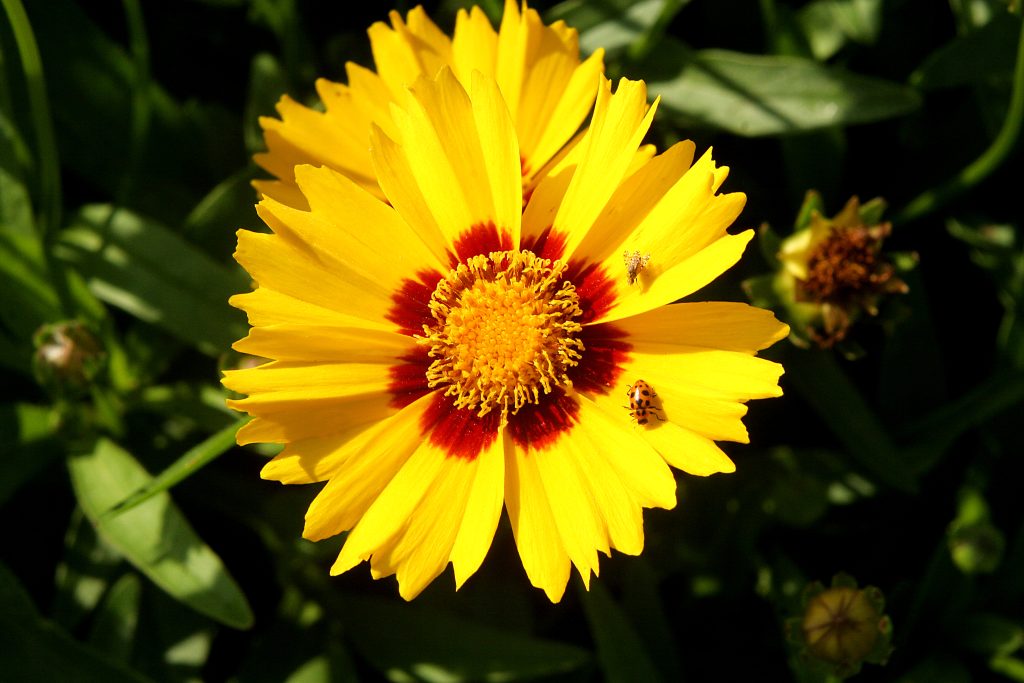
October 2008 IFAS Extension Calendar Photo. Corey Yellow Coreopsis, flower. UF/IFAS Photo: Thomas Wright.
Coreopsis, also known as tickseed, is Florida’s state wildflower. These bright, yellow flowers are a favorite among native bees and butterflies. Coreopsis blooms from spring through fall, providing a long-lasting nectar source. They thrive in full sun and well-drained soil, making them an excellent choice for gardens and landscapes across the state.
Black-Eyed Susan (Rudbeckia hirta)
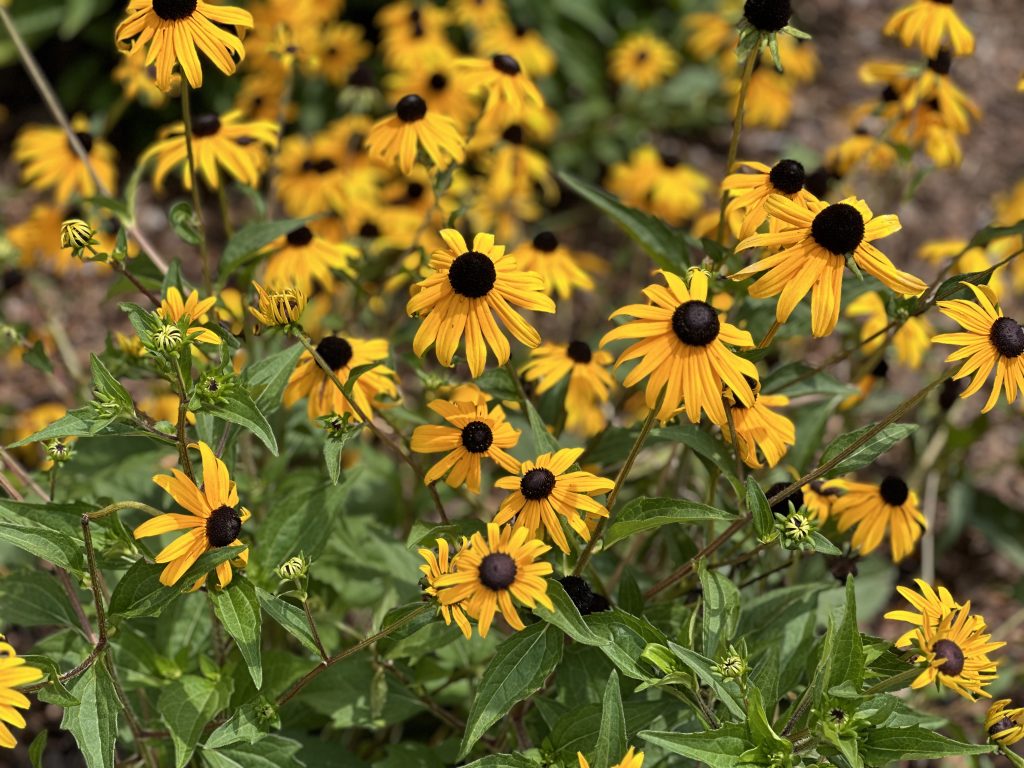
Rudbeckia hirta Photo Credit: Danielle Williams, UF/IFAS Extension Gadsden County
Black-eyed Susans are easily recognizable by their bright yellow petals and dark brown centers. These hardy perennials attract a variety of pollinators, including bees and butterflies. They are drought-tolerant and prefer full sun, making them a resilient addition to any garden.
Blanket Flower (Gaillardia pulchella)
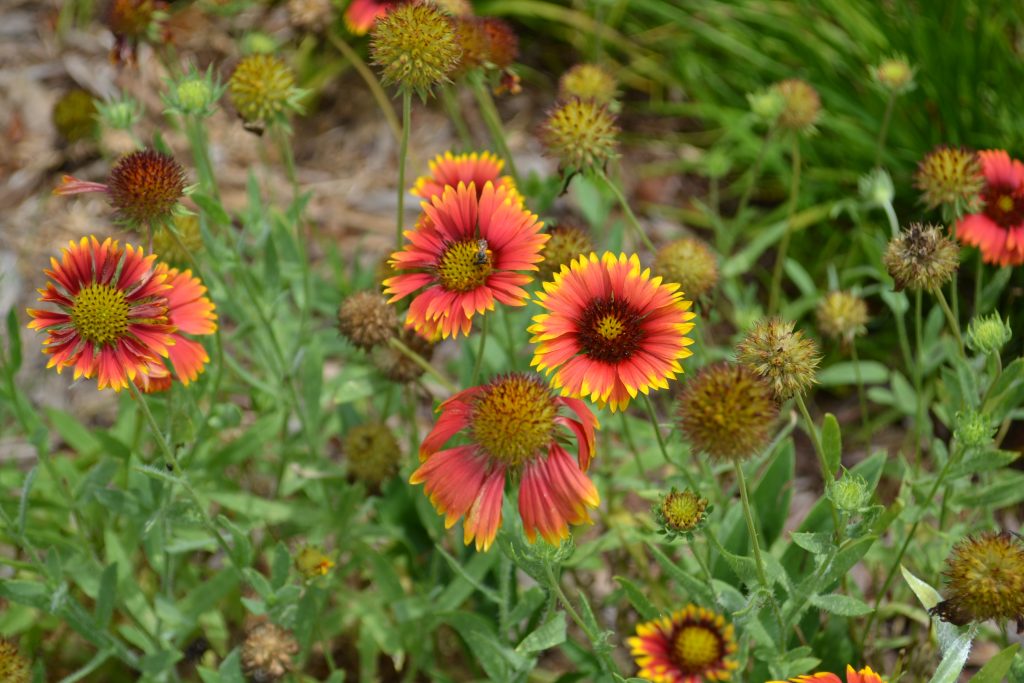
Photo Credit: Beth Bolles, UF/IFAS Extension Escambia County
Blanket Flower, also known as Firewheel, can be found throughout Florida in dry, sandy soils and sunny conditions. It is also a hardy perennial and is known for its long blooming period from spring to fall. The red and yellow blooms are a perfect pollinator attractant, particularly bees and butterflies.
Purple Coneflower (Echinacea purpurea)
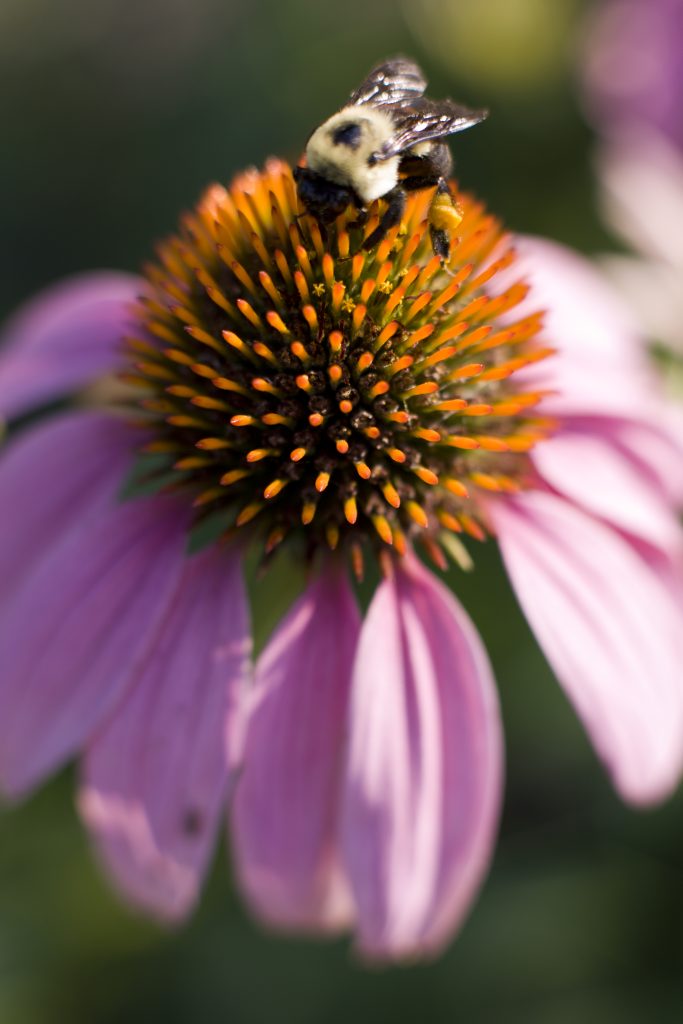
Flowers and insects at the student gardens on the University of Florida campus. Pollinating bee. UF/IFAS Photo by Tyler Jones.
Purple coneflowers are not only striking with their large, purple petals and spiky centers but are also magnets for bees and butterflies. The nectar of this flower will attract a variation of bees, butterflies, and some hummingbirds, but the seeds that the coneflower produces can be eaten by wildlife. The purple coneflower is considered an endangered native Florida wildflower and can only be found naturally in Gadsden County.
American beautyberry (Callicarpa americana)
While this is not a “traditional” wildflower, the beautyberry is an important native pollinator plant and food source for wildlife. The flowers are small in size and vary from light pink to lavender in color. The blooms open in late spring/early summer and produce a purple berry that can be an additional food source for birds and other animals.
By choosing to plant native wildflowers, you can create a vibrant and thriving garden or landscape bed that supports Florida’s native pollinators. For more information on Florida’s native wildflowers please visit:
https://www.flawildflowers.org/
https://edis.ifas.ufl.edu/publication/EP297
https://edis.ifas.ufl.edu/topics/wildflowers
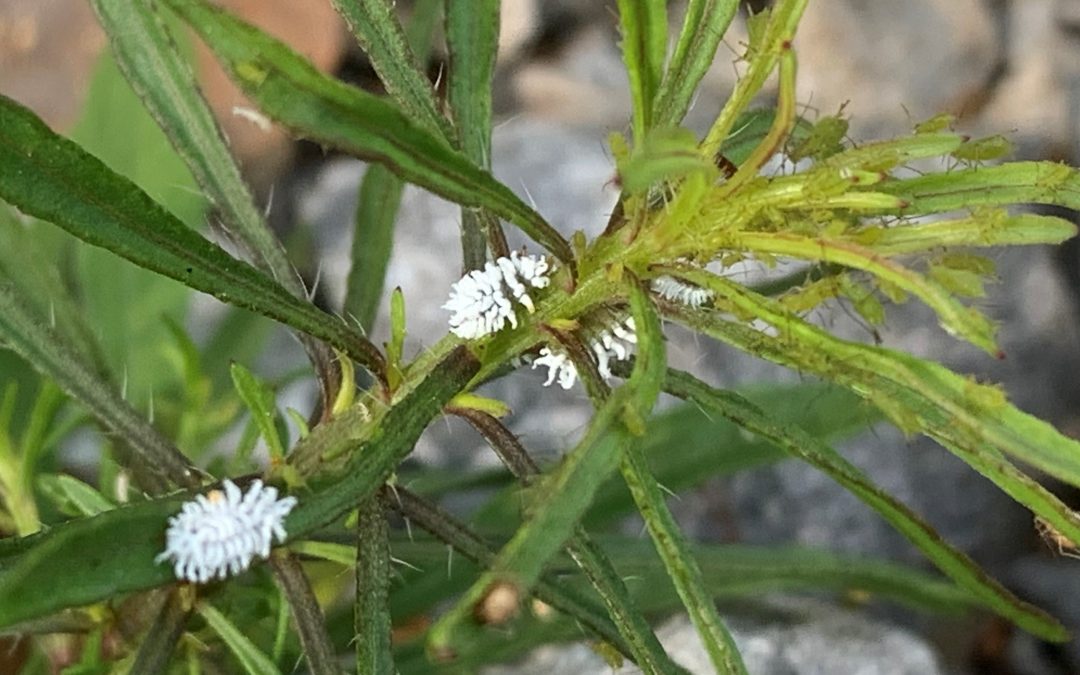
by Beth Bolles | May 23, 2024
Scouting is an important part of keeping pests in check and gardeners are often up to the task. As you routinely enjoy the beauty of your ornamental and edible plants, you are likely to catch a pest sighting before it gets out of control. One insect that may trick us upon first glance into thinking we have a pest is an interesting lady beetle called the Mealybug destroyer.
Lady beetles are one of the most recognizable insects in the garden with their rounded shiny bodies and often bright colors and spots. The adult mealybug destroyer is smaller than a typical lady beetle, about 1/8 of an inch long, with a dark brownish black body and dull orangish head. They move quickly over flowers and leaves in search of food. The larval stage can be confusing because immatures look very similar to mealybugs, one of their favorite prey. Larva have white, woolly protuberances on the body. Whereas pest mealybugs look flatter, the mealybug destroyer immatures have parts that look like soft white spikes.
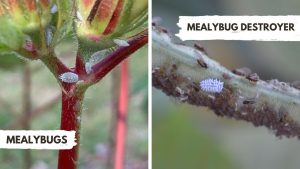
Pest mealybug compared to beneficial mealybug destroyer. Photos by Beth Bolles, UF IFAS Extension Escambia County.
Why not learn to recognize an insect that eats lots of soft bodied pests on your plants? Once you see one, you will be able to spot these beneficials more often on your favorite garden flowers.
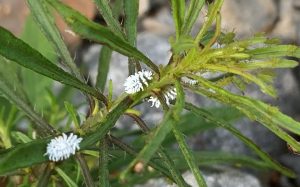
Mealybug destroyer immatures feeding on aphids. Photo by Beth Bolles, UF IFAS Extension Escambia County
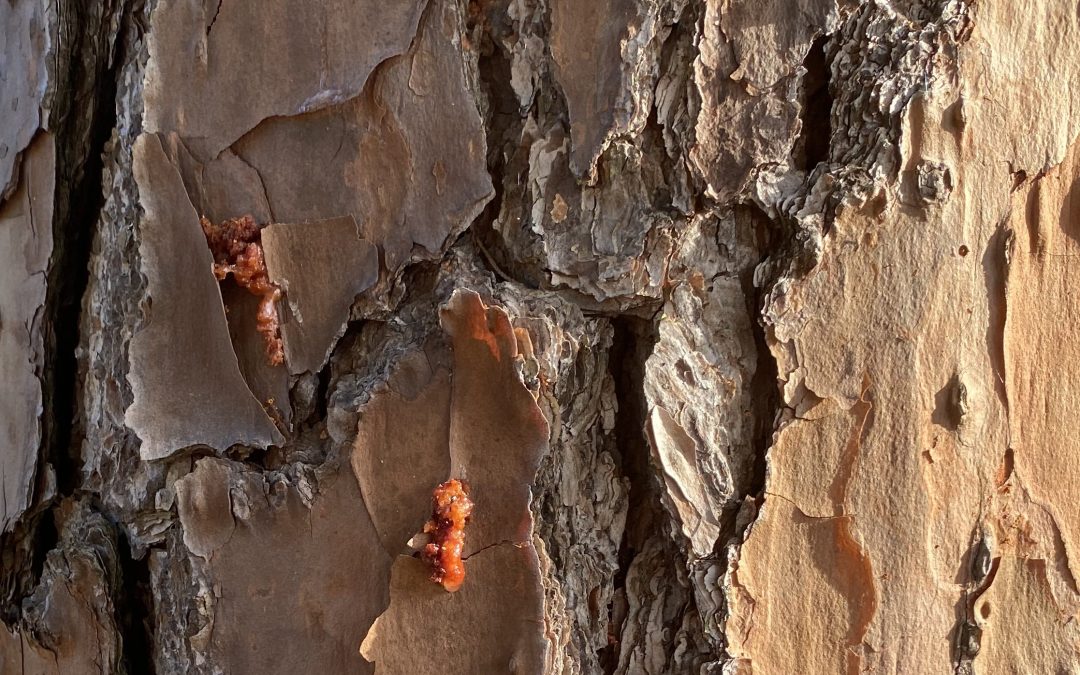
by Ian Stone | May 9, 2024
Pine Bark Beetles are an ever-present issue in both the urban and rural landscape across the Panhandle. If you have pines in your landscape you very well may experience issues with pine bark beetles. The tiny insects can decimate a pine rather quickly, and there are more than one type that can infest a tree. The Southern Pine Beetle is the bark beetle that most people are familiar with and most concerned about. In forestry settings the Southern Pine Beetle can have epidemic outbreaks that can devastate large areas of pine forests and plantation. While the Southern Pine Beetle is very destructive and a concern to forest health, there are other common pine bark beetles that often attack trees in our area. The two other common bark beetles are Ips pine engraver beetles and Black Turpentine Beetles. In urban settings these two beetles often are more common but they can easily wipe out several trees or more, which may pose a significant issue in the landscape.
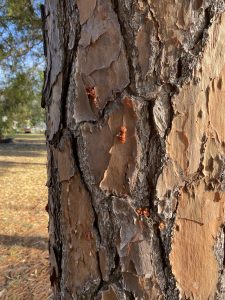
Resin pitches on bark that indicate pine bark beetle infestation. This shows a pine that is actively colonized by bark beetles and should be removed.
Photo Credit-Ian Stone
There are multiple species of Ips beetles and these tend to be a significant issue in landscapes, because they can easily wipe out most of the trees in a yard or park. They almost always target stressed or damaged trees, but they usually do not wipe out large areas like Southern Pine Beetle. Different Ips species will often attack different portions of the tree which can result in partial dieback of the crown or a slow yellowing and browning of the foliage. These beetles are very small, smaller than a grain of rice, and often are not seen readily without close inspection. Like other bark beetles the bark will often have resin oozing out and forming small pockets resembling popcorn. Other signs include yellowing and browning foliage and an accumulation of sawdust like material around the base. You may also see exit holes in the bark about the size of a pencil lead.
The Black Turpentine Beetle is closely related to the Southern Pine Beetle, but much larger and often attacks the lower portion of the tree. These beetles commonly attack older, damaged, and weakened trees. Historically they were often associated with turpentining operations and trees that had been worked for resin production, hence their common name. They are very attracted to trees that are damaged by equipment or that have had construction occur around them recently. The symptoms are generally the same as other pine bark beetles, but the resin pitches are larger and the exit holes are about the size of an eraser. While they are larger than other bark beetle they are still quite small by comparison to other insects, not much larger than a grain of rice and somewhat smaller than a pea.
If you notice pines in your area with bark beetle symptoms it is natural to be concerned. As the weather warms bark beetle activity increases and you may notice these symptoms on your pines. If you had bark beetles attack a tree in your yard last year you will want to keep an eye out for other pines being attacked in the spring. With the drought last year bark beetle activity increased and if the infected trees were not removed spots may reactivate in the spring and summer. Unfortunately, once bark beetles attack a pine there is really nothing to do other than removal. Insecticides and sprays will not do anything against bark beetles that are already in the tree. If you have high value pines in your landscape you want to preserve, prevention is key. First and foremost avoiding issues from equipment damage and construction is key as this will attract beetles. Preventative injections with systemic insecticides by a licensed professional can protect trees in your landscape. If you have noticed bark beetle activity in the area or have had to recently remove trees that died from bark beetles, consider preventative treatment to preserve trees that are at risk. Otherwise removing trees that become infested with bark beetles promptly is the best solution. Sometimes it can be difficult to determine what trees to remove, but any trees showing active bark beetle activity should be removed to prevent spread. Once bark beetles have colonized a tree and it is in decline preventative insecticide treatments are not going to be effective. You also don’t need to remove every pine in your landscape just because a single tree has bark beetles. At the following link you will find an IFAS EDIS article that is helpful in identifying bark beetles and making a decision about an infected tree https://edis.ifas.ufl.edu/publication/FR399.
If you see bark beetle activity on your property this spring contact your local IFAS extension office or your Florida Forest Service County Forester’s office for assistance and information. A Certified Arborist can assist you with determining how to remove infected trees or apply preventative treatments to trees at risk. With good decision making and management pine bark beetle attacks can be managed before they grow and spread. Now is a good time to keep an eye out and get ahead of any infestations that start.
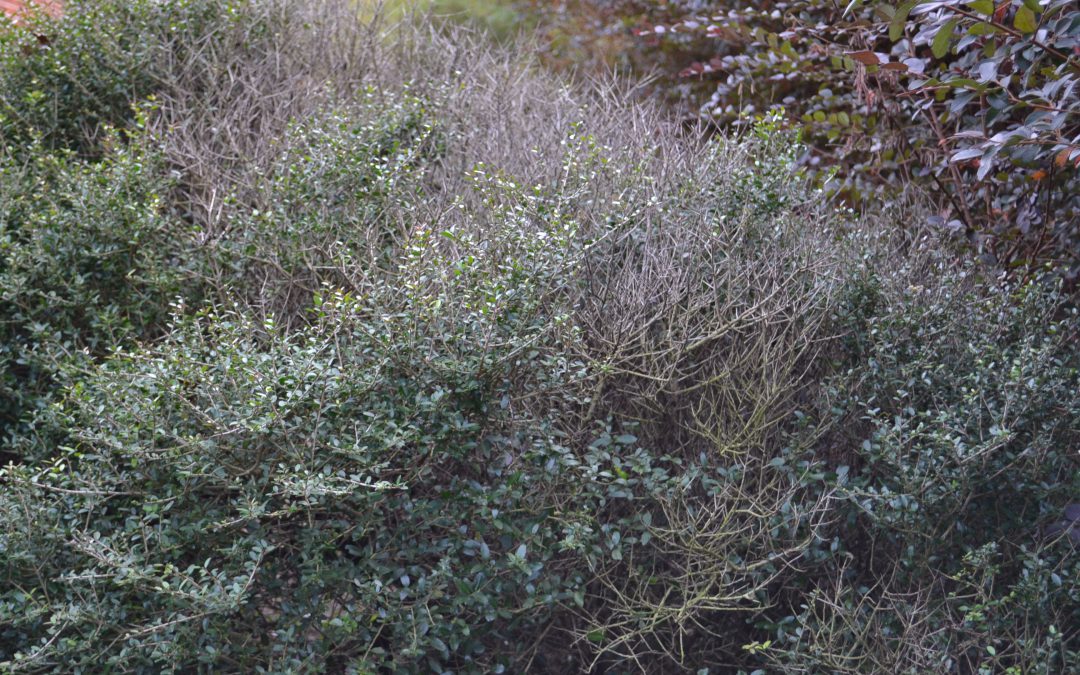
by Daniel J. Leonard | May 9, 2024
In the last couple of weeks, I’ve had multiple questions regarding trees and shrubs that aren’t looking too hot. These types of calls are common this time of year – it has gotten hot and dry, and plants have fully emerged from winter, causing issues that have been hiding under the surface during the dormant season to manifest as crown or branch dieback. While there are a wide variety of things that can cause dieback, in most cases a little detective work can help pinpoint the issue. Let’s look at a few of the most common causes of dieback and some corrective measures that may help restore the plants to health.
The first thing to do when you notice a plant in decline is nothing. Don’t try and oversaturate it with water. Don’t run out and dump a bunch of fertilizer around it. Many times, these panic measures exacerbate the stress the plant is already under. Instead, I encourage you to give us a call at your local UF/IFAS County Extension Office. We can likely help identify the cause of the problem through a site visit to your property or by you sending us diagnostic photos of the plant with a description of what’s been going on with it – the more information you can provide about the plant and the management practices it has experienced, the better (you can email diagnostic images/information to d.leonard@ufl.edu).
The most common cause of tree/shrub dieback that I see arises from improper planting practices. Most landscape plants should be planted at or just above the surrounding soil level, preferably where the topmost root arises from the trunk. To accomplish this, planting holes should be dug slightly shallower than the rootball’s height and about twice as wide. Planting any deeper than that is probably too deep and can cause problems like trunk and root decay, which lead to crown dieback. Unfortunately, once a plant is planted too deep, it cannot be corrected other than digging up and replanting at the proper depth, which may or may not be possible depending on the size of the tree. Another common issue that can arise after planting is girdling roots. This occurs when plants are grown in plastic containers and develop a root system that circles the inner wall of the pot. If not trimmed, the plant’s root system will continue to grow in this manner, eventually encircling the plant’s trunk, cutting off water and nutrient flow, and leading to crown dieback. Fortunately, this condition can be prevented by cutting, removing, or redirecting these roots at planting.
The next most common cause of plant dieback occurs due to soil disturbance by people. It’s easy to forget but the root zone of trees and shrubs can reach out several times farther than the plant is tall and is easily damaged. Disturbances to the root zone from digging or trenching near trees or compaction from prolonged vehicle travel over the area cause damage that might be slow to appear but can lead to plant decline. If you are doing construction or building near a shrub or tree, try to keep digging machinery as far out of the root zone as possible and avoid repeatedly parking or driving vehicles over the root zone area. Like below ground root damage, trunk damage that occurs from injury by string trimmers, mowers, or animal feeding activity can all disrupt the flow of water and nutrients in plants and prove deadly. There is no cure for this type of damage, so employing physical barriers to prevent damage is key.
The last major stress is environmental in nature and is caused by a water imbalance – either too much or not enough. Dry soil conditions during the planting and establishment phases (first several years after planting) should obviously be avoided if possible – keeping the developing rootzone moist and allowing plant roots to establish in their native soil is critical. Too much water can also cause problems for trees planted in poorly drained soil. Excessive moisture leads to root diseases, which ultimately presents as dieback in the canopy. If planting in an area that tends to stay wet, select a species of plant adapted for that sort of site – some species are more tolerant of “wet feet” than others. While many people expect disease and insect damage to be the cause of an unhealthy plant, they’re often not the biggest culprit and, if they occur at all, are generally secondary to one of the above issues.
For more information about crown dieback or declining landscape plants, contact your local UF/IFAS County Extension office. Happy gardening!
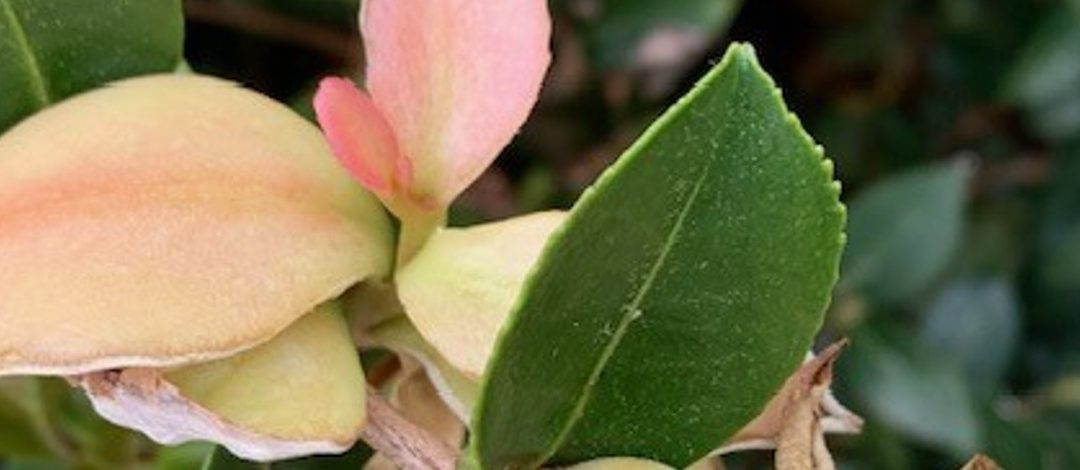
by Larry Williams | May 2, 2024
Q. Some of the leaves on my azalea and/or camellia are swollen and light green. What caused this?
A. This is caused by a fungus that has been relatively common this spring.
The fungus Exobasidium vaccinii causes leaves and flowers to become swollen or thickened, curled and waxy in appearance. This fungus causes leaves, and in some cases flower petals, to enlarge abnormally and is commonly referred to as azalea or camellia leaf and flower gall.
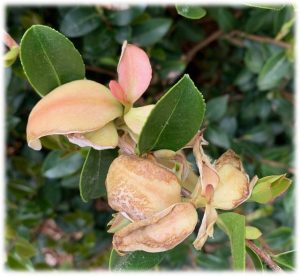
Exobasidium leaf gall on camellia. Credit: Larry Williams
Symptoms vary somewhat based on the host plant. In addition to azalea and sasanqua camellia, it can occur on blueberry, as well. Infected blueberry leaves turn an unusual bright red in spring with almost no swelling of tissue. With azaleas and camellias, leaves become large and distorted and eventually a white powder covers the galls. The white growth consists of spores, which is how the fungus reproduces. Galls ultimately turn brown and harden. Not every leaf will be infected. It’s more common for the plant’s lower leaves to be the most heavily infected but under humid conditions and in shaded locations galls may form on leaves throughout the plant canopy.
The disease relies on airborne spores produced in the whitish mold on the surface of galls in late spring to early summer to reproduce. The galls then form the following spring. It’s important to remove and dispose of infected leaves before they turn white with spores.
Once you see evidence of infected leaves, it’s too late for chemical control. Besides, there currently is no effective or practical fungicide to control this disease in the home landscape. But you can reduce the amount of infection on your plants the following year by pruning infected leaves and throwing them away before spores are produced. After removing infected leaves with galls, never leave them on the ground around the plants.
It’s best to bury, burn or place the infected leaves in a plastic bag and throw them away. This disease is more severe during a cool, wet spring. It’s advisable to not add to the problem by artificially providing the “wet weather” the spores need by frequently using an overhead sprinkler and keeping the foliage wet in the spring during disease development. This is exactly what this and many other plant diseases need – wet conditions. Yet another reason to water during early morning and on an as needed basis, versus allowing an irrigation system to frequently run when there is already adequate moisture from rain.
In the home landscape, the fungus does not cause any long-term problems for the plant. It just makes the plant’s leaves look ugly. The infected leaves will usually fall prematurely.













